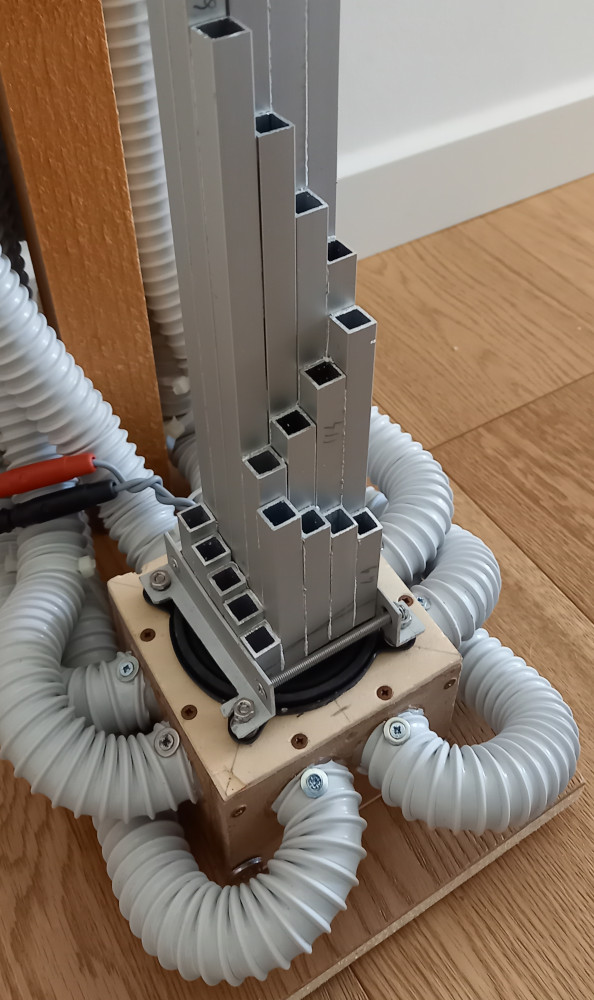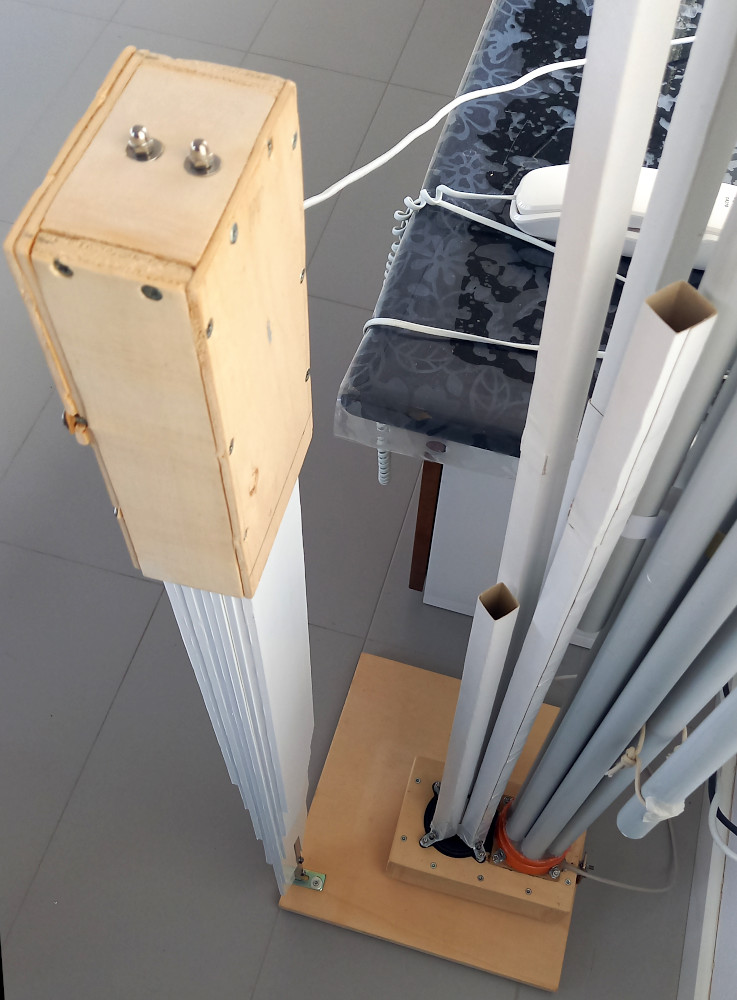


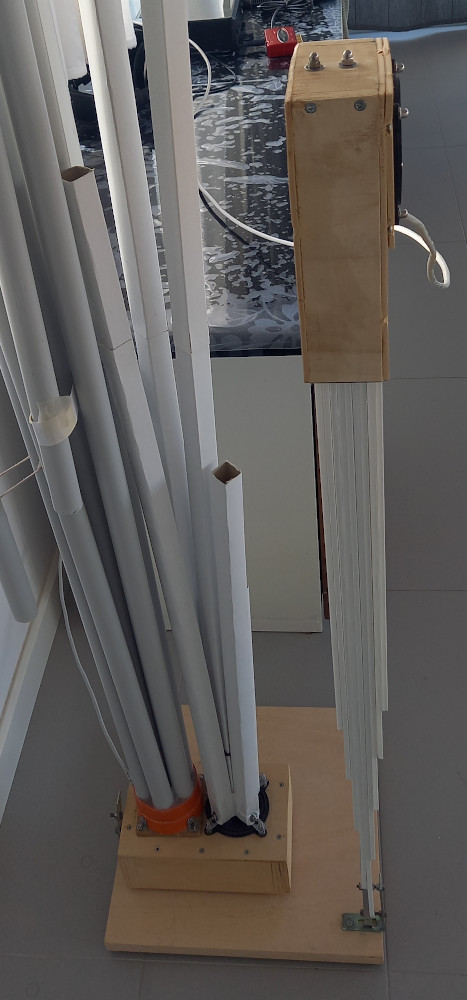


mddOmni - carico acustico frontale - front acoustic load - home






mddOmni - home
Il carico acustico frontale mddOmni:
- rende tridimensionale la scena sonora (3D),
- migliora la percezione dei suoni in una stanza non trattata acusticamente (anti Haas effect),
- rende omnidirezionale la cassa acustica (omni).
The mddOmni frontal acoustic load:
- makes the sound scene three-dimensional (3D),
- improves the perception of sounds in a room not acoustically treated (anti Haas effect),
- makes the speaker omnidirectional (omni).
Una serie di guide d'onda di lunghezza crescente sono posizionate di fronte al driver. In ogni guida entra una parte dell'energia acustica emessa dal cono del driver. La stessa energia è riemessa in posizioni diverse, con ritardi crescenti, con un fronti d'onda sferici e coerenti con l'emissione diretta del driver. Negli ultimi prototipi le guide sono aperte a entrambi i lati con risonanze a L/2.
A series of waveguides of increasing length are positioned in front of the driver. A part of the acoustic energy emitted by the driver cone enters each guide. The same energy is re-emitted in different positions, with increasing delays, with spherical wave fronts and consistent with the direct emission of the driver. In the latest prototypes the guides are open on both sides with L/2 resonances.
link - home
- MDD Multi Delays Diffraction
- mddOmni
- 3D effect
- anti Haas effect
- diffrattore acustico omnidirezionale - omnidirectional acoustic diffractor
- psicoacustica - psychoacoustics
- mddOmni diy
- mddTL
- cabinet neutro - neutral cabinet
- logarithmic sum
- mddTL diy
- supporto a risonanza subsonica - subsonic resonance support
- base asimmetrica - asymmetric base
- 3FE25
- stereo
Le emissioni multiple simulano sorgenti sonore tridimensionali. Uno strumento emette suoni da più punti contemporaneamente, i punti di emissione multipli simulano lo strumento in 3D. I prototipi MDD non sono in grado di ricreare la dimensione esatta dello strumento originale ma l'ascolto migliora rispetto alla riproduzione di una sorgente puntiforme.
Multiple emissions simulate three-dimensional sound sources. An instrument emits sounds from multiple points at the same time, the multiple emission points simulate the instrument in 3D. The MDD prototypes are not able to recreate the exact size of the original instrument but the listening improves compared to the reproduction of a point source.
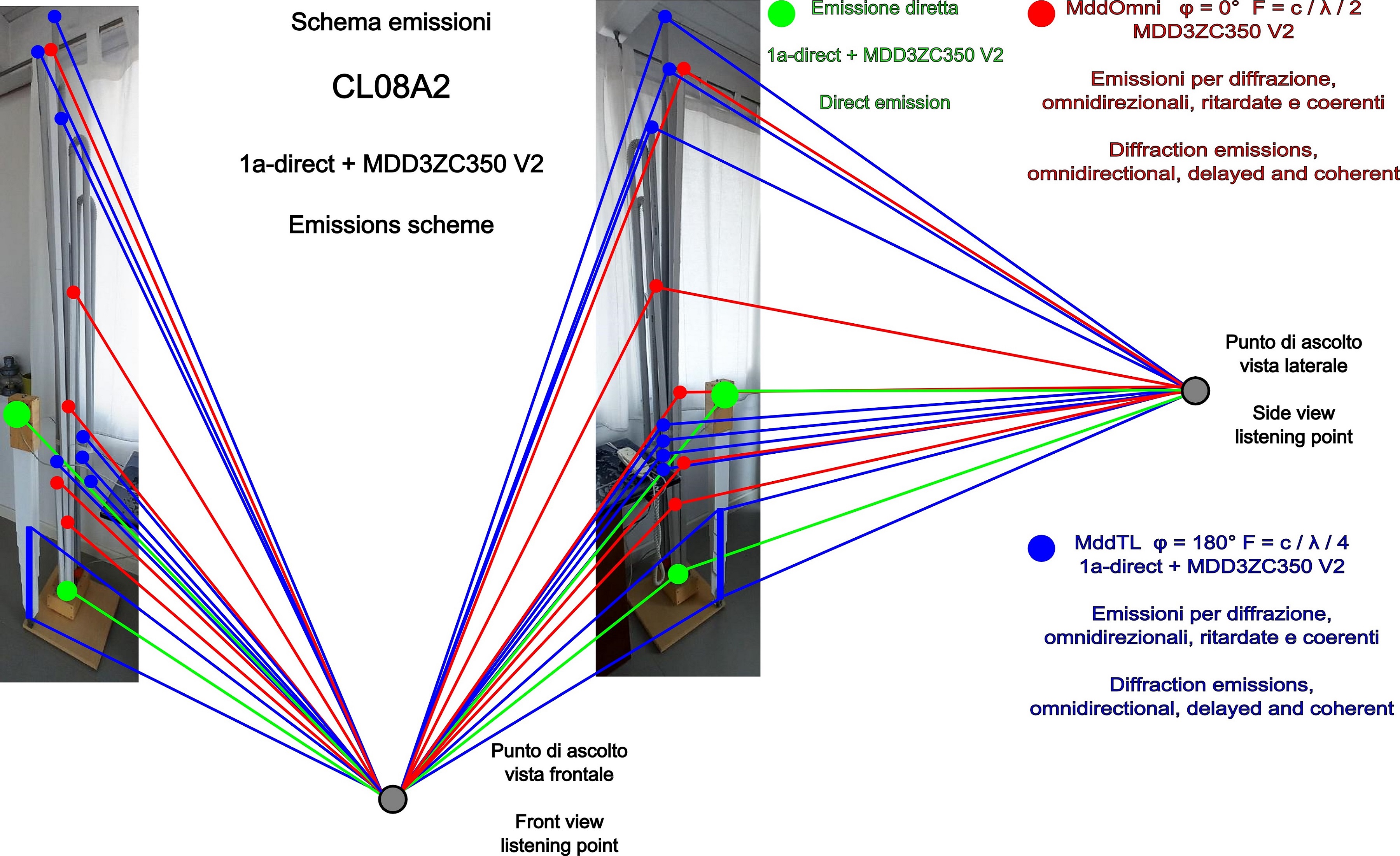
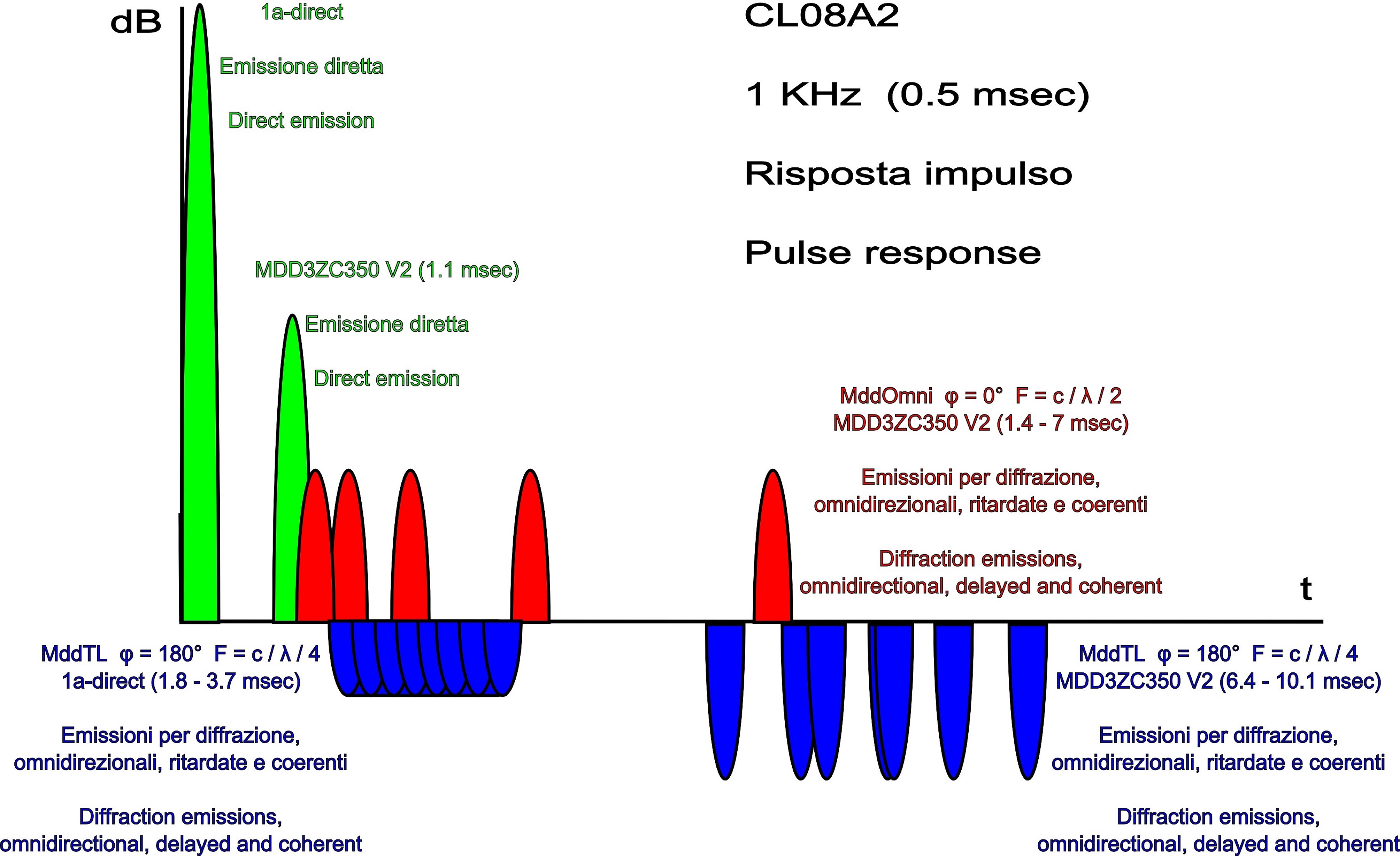
Nello schema sono visualizzate le emissioni del prototipo CL08A2 (1a-direct + MDD3ZC350 V2).
The emissions of the CL08A2 prototype (1a-direct + MDD3ZC350 V2) are displayed in the diagram.
L'emissione primaria e direzionale del prototipo 1a-direct è rappresentata con il colore verde al tempo zero. Anche il prototipo MDD3ZC350 V2 ha una emissione diretta, parziale, coerente, ritardata indicata con il colore verde.
The primary and directional emission of the prototype 1a-direct is represented with the green color at time zero. The prototype MDD3ZC350 V2 also has a direct, partial, coherent, delayed emission indicated by the green color.
Il colore rosso indica le emissioni coerenti, ritardate e omnidirezionali del carico acustico frontale mddOmni del prototipo MDD3ZC350 V2.
The red color indicates the coherent, delayed and omnidirectional emissions of the mddOmni frontal acoustic load of the MDD3ZC350 V2 prototype.
L'effetto 3D è aumentato dalle emissioni dei carichi acustici posteriori mddTL dei prototipi 1a-direct e MDD3ZC350 V2 indicate con il colore blu.
The 3D effect is increased by the emissions of the rear acoustic loads mddTL of the 1a-direct prototypes and MDD3ZC350 V2 indicated in blue.
Nel prototipo del progetto CL08A2 ci sono decine di punti di emissione coerente, ritardata, omnidirezionale distribuiti in un volume di 2300 x 340 x 340 mm. La distribuzione è fissata in fase di costruzione per cui la dimensione e la posizione degli strumenti nella scena sonora è meno sensibile alle riflessioni dell'ambiente d'ascolto di un'unica sorgente puntiforme.
In the prototype of the project CL08A2 there are dozens of coherent, delayed, omnidirectional emission points distributed in a volume of 2300 x 340 x 340 mm. The distribution is fixed during the construction phase so the size and position of the instruments in the sound stage is less sensitive to reflections from the listening environment than a single point source.
La prima emissione diretta del driver arriva alle orecchie dell'ascoltatore percorrendo il percorso rettilineo più breve. La serie di emissioni coerenti, ritardate e omnidirezionali delle guide d'onda in punti diversi dello spazio arrivano nel punto d'ascolto prima delle riflessioni generate dagli oggetti e dalle pareti dell'ambiente. Aumenta il realismo della riproduzione e il riconoscimento dei suoni registrati è più facile.
The first direct emission of the driver reaches the listener's ears along the shortest straight path. The series of coherent, delayed and omnidirectional emissions from the waveguides at different points in the space arrive at the listening point before the reflections generated by the objects and walls of the environment. It increases the realism of playback and the recognition of recorded sounds is easier.
Le emissioni secondarie ritardate e coerenti potrebbero essere generate elettronicamente o con altoparlanti multipli. Sono in commercio vari tipi di dispositivi di condizionamento del segnale che hanno lo scopo di migliorare la percezione dei suoni riprodotti con algoritmi specifici. Anche un array di altoparlanti, diffusori planari con dimensione superiore al metro o la configurazione D'Appolito generano fronti sonori coerenti e ritardati.
Delayed and coherent secondary emissions could be generated electronically or with multiple speakers. Various types of signal conditioning devices are on the market which aim to improve the perception of sounds reproduced with specific algorithms. Even a speaker array, planar speakers larger than one meter in size or the D'Appolito configuration generate coherent and delayed sound fronts.
Le emissioni secondarie ritardate e coerenti aumentano il realismo della riproduzione in quanto simulano la presenza di fronti sonori emessi nello stesso istante da punti diversi della sorgente sonora registrata. Negli strumenti musicali, nelle persone, negli animali non è mai un unico punto ad emettere energia sonora, ritardi di 2-5 millisecondi simulano l'effetto prodotto da strumenti o corpi di 70-170 centimetri. Le emissioni ritardate e coerenti prodotte dagli altoparlanti MDD hanno ritardi adatti e provengono effettivamente da punti diversi nello spazio. Nessuna sorgente puntiforme può ricreare questo effetto senza una complessa rielaborazione del segnale stereo registrato che, inoltre, resta valida in zone limitate dell'ambiente d'ascolto.
The delayed and coherent secondary emissions increase the realism of the reproduction as they simulate the presence of sound fronts emitted at the same time from different points of the recorded sound source. In musical instruments, people and animals it is never a single point that emits sound energy, delays of 2-5 milliseconds simulate the effect produced by instruments or bodies measuring 70-170 centimetres. The delayed, coherent emissions produced by MDD speakers have suitable delays and actually come from different points in space. No point source can recreate this effect without a complex reprocessing of the recorded stereo signal which, moreover, remains valid in limited areas of the listening environment.
L'effetto Haas (precedenza) si manifesta quando due suoni identici arrivano all'orecchio in successione. Con ritardi superiori a 5 millisecondi con suoni semplici (click) l'udito percepisce suoni distinti. Con suoni più complessi il tempo sale a 40 millisecondi. I punti di emissione del carico acustico mddOmni si trovano a distanze crescenti dal driver e i fronti sonori hanno ritardi compresi fra 1 e 10 millisecondi. La successione dei fronti sonori impedisce l'attivazione dell'effetto Haas, un singolo evento non può essere percepito come due suoni distinti.
The Haas effect (precedence) occurs when two identical sounds arrive at the ear in succession. With delays greater than 5 milliseconds with simple sounds (click) the ear perceives distinct sounds. With more complex sounds the time increases to 40 milliseconds. The emission points of the mddOmni acoustic load are located at increasing distances from the driver and the sound fronts have delays between 1 and 10 milliseconds. The succession of sound fronts prevents the activation of the Haas effect, a single event cannot be perceived as two distinct sounds.

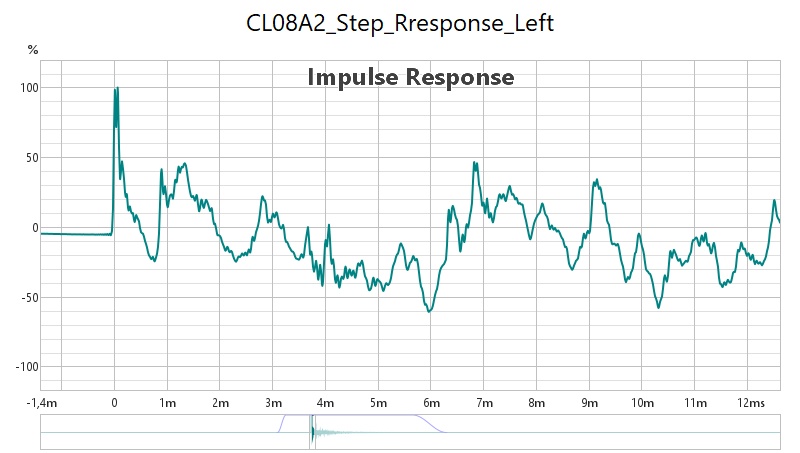 La tecnologia MDD è utilizzabile anche in ambienti d'ascolto molto riflettenti. I ritardi ottimizzano l'ascolto in ambienti non trattati acusticamente, è lo stesso effetto che si ottiene con l'applicazione alle pareti di diffrattori passivi. Le guide d'onda generano ritardi compresi fra 0 e 10 millisecondi, l'inviluppo delle emissioni si espande (dura più a lungo nel punto d'ascolto) e le riflessioni sono percepite come generate dalla stessa origine, la fatica d'ascolto diminuisce e il riconoscimento dei suoni è più facile. L'emissione omnidirezionale con la moltiplicazione dei possibili percorsi riduce ulteriormente la possibilità di attivazione dell'effetto Haas.
La tecnologia MDD è utilizzabile anche in ambienti d'ascolto molto riflettenti. I ritardi ottimizzano l'ascolto in ambienti non trattati acusticamente, è lo stesso effetto che si ottiene con l'applicazione alle pareti di diffrattori passivi. Le guide d'onda generano ritardi compresi fra 0 e 10 millisecondi, l'inviluppo delle emissioni si espande (dura più a lungo nel punto d'ascolto) e le riflessioni sono percepite come generate dalla stessa origine, la fatica d'ascolto diminuisce e il riconoscimento dei suoni è più facile. L'emissione omnidirezionale con la moltiplicazione dei possibili percorsi riduce ulteriormente la possibilità di attivazione dell'effetto Haas.
MDD technology can also be used in highly reflective listening environments. The delays optimize listening in environments that are not acoustically treated, it is the same effect that is obtained by applying passive diffractors to the walls. The waveguides generate delays between 0 and 10 milliseconds, the emission envelope expands (lasts longer at the listening point) and the reflections are perceived as generated from the same origin, listening fatigue decreases and recognizing sounds is easier. Omnidirectional emission with the multiplication of possible paths further reduces the possibility of triggering the Haas effect.
Nella misura della risposta allo step si vede anche l'effetto delle riflessioni nell'ambiente d'ascolto.
When measuring the response to the step you can also see the effect of the reflections in the listening environment.

 Voglio fare un esempio con le immagini sulle copertine di due album.
Voglio fare un esempio con le immagini sulle copertine di due album.
I want to give an example with images on the covers of two albums.
- La copertina di sinistra è dell'album "100% YES" dei Melt Yourself Down. Rappresenta un impianto di riproduzione audio con sorgente puntiforme e un ambiente di ascolto che genera una riflessione. L'ascoltatore in questo caso deve elaborare due informazioni distinte, l'impressione è di fastidio, fatica d'ascolto.
- The cover on the left is from the album "100% YES" by Melt Yourself Down. It represents an audio reproduction system with a point source and a listening environment that generates a reflection. In this case the listener must process two distinct pieces of information, the impression is one of annoyance and listening fatigue.
- La copertina di destra è dell'album "All the Lost Souls" di James Blunt. Rappresenta un impianto di riproduzione MDD. Le emissioni multiple e omnidirezionali generano moltissime riflessioni e impediscono che queste si possano interpretare come una informazione distinta. Le singole emissioni e riflessioni possono essere diverse dall'immagine nel suo insieme. L'ascoltatore in questo caso percepisce una sola informazione con un rumore di fondo. La mia ipotesi di lavoro è: per il cervello eliminare il rumore di fondo da una informazione è più semplice che gestire due informazioni.
- The cover on the right is from the album "All the Lost Souls" by James Blunt. Represents an MDD reproduction system. Multiple and omnidirectional emissions generate many reflections and prevent these from being interpreted as distinct information. Individual emissions and reflections may be different from the image as a whole. In this case the listener perceives only one piece of information with background noise. My working hypothesis is: for the brain, eliminating background noise from one piece of information is simpler than managing two pieces of information.
Il senso dell'udito si è evoluto per riconoscere la sorgente sonora e l'ambiente che la circonda, la sorgente è un termine di paragone per avere informazioni sull'ambiente d'ascolto e le riflessioni dell'ambiente possono complicare il riconoscimento del suono. Uno stereo può riprodurre alla perfezione le riflessioni registrate di un ambiente con caratteristiche acustiche totalmente diverso da quello in cui si ascolta. Può capitare che il locale d'ascolto aggiunga riflessioni che confondono il cervello con segnali in contrasto con i segnali registrati.
The sense of hearing has evolved to recognize the sound source and the environment that surrounds it, the source is a term of comparison for obtaining information on the listening environment and the reflections of the environment can complicate sound recognition. A stereo can perfectly reproduce the recorded reflections of an environment with acoustic characteristics that are totally different from the one in which you are listening. It may happen that the listening room adds reflections that confuse the brain with signals that conflict with the recorded signals.
Un impianto audio di alta qualità in una stanza trattata riprodurrà una immagine molto dettagliata e senza fatica d'ascolto. In una stanza con problemi di acustica un impianto MDD darà meno fatica d'ascolto anche se realizzato con apparecchi di qualità inferiore. In stanze trattate con apparecchi di qualità anche la tecnologia MDD può riprodurre immagini dettagliate e senza fatica d'ascolto.
A high quality audio system in a treated room will reproduce a very detailed image without listening fatigue. In a room with acoustic problems, an MDD system will give less listening effort even if made with lower quality equipment. In rooms treated with quality equipment, MDD technology can also reproduce detailed images without listening fatigue.
Usando uno stereo con sorgenti puntiformi all'ascoltatore arriva prima il suono diretto della sorgente registrata che contiene segnali emessi in posizioni diverse nello stesso istante, i ritardi sono corretti ma risultano riprodotti su una linea monodimensionale che unisce i due diffusori. Se la stanza d'ascolto è più piccola del locale della registrazione, successivamente arrivano le riflessioni introdotte dalla stanza e infine le riflessioni presenti nel locale in cui è avvenuta la registrazione. L'ascoltatore deve decodificare tre informazioni non coerenti: la sorgente sonora tridimensionale riprodotta come sorgente monodimensionale, l'ambiente d'ascolto che riflette le onde sonore di una sorgente monodimensionale, le riflessioni dell'ambiente della registrazione che può essere molto diverso. Può essere un'esperienza sgradevole. Per migliorare le cose si può eliminare la sorgente puntiforme con un array di altoparlanti, diffusori planari o una configurazione D'Appolito e trattare la stanza d'ascolto per minimizzare le riflessioni tipiche del locale. Il risultato è la riproduzione più fedele possibile all'esecuzione originale, chiudendo gli occhi si può avere l'impressione di assistere all'evento. Spesso l'area d'ascolto ottimale si riduce ad una zona limitata in corrispondenza del vertice del triangolo con alla base la linea che unisce i due diffusori.
Using a stereo with point sources, the direct sound of the recorded source reaches the listener first, which contains signals emitted in different positions at the same time, the delays are corrected but are reproduced on a one-dimensional line that joins the two speakers. If the listening room is smaller than the recording room, then come the reflections introduced by the room and finally the reflections present in the room where the recording took place. The listener must decode three inconsistent pieces of information: the three-dimensional sound source reproduced as a one-dimensional source, the listening environment that reflects the sound waves of a one-dimensional source, the reflections of the recording environment which can be very different. It can be an unpleasant experience. To improve things, you can eliminate the point source with a speaker array, planar speakers or a D'Appolito configuration and treat the listening room to minimize room-specific reflections. The result is the most faithful reproduction possible of the original performance, by closing your eyes you can have the impression of witnessing the event. Often the optimal listening area is reduced to a limited area corresponding to the vertex of the triangle with the line joining the two speakers at the base.
Le emozioni prodotte dall'ascolto della musica registrata si possono ottenere anche senza trattare acusticamente il locale e con un economico altoparlante larga-banda utilizzando casse acustiche MDD.
The emotions produced by listening to recorded music can also be obtained without acoustically treating the room and with an economical broadband speaker using MDD loudspeakers.
I diffrattori acustici a guida d'onda aggiungono onde secondarie ritardate e coerenti a tutti i suoni anche se la registrazione è stata fatta con microfoni posizionati in punti non ideali. L'effetto potrebbe modificare la percezione delle dimensioni della sorgente registrata ma in nessun caso può farla ridiventare monodimensionale. Le onde primarie e quelle secondarie sono riflesse dall'ambiente e arrivano all'ascoltatore che le percepisce come compatibili con una sorgente tridimensionale presente nella stanza. L'emissione omnidirezionale in un ambiente riflettente aumenta l'effetto delle onde riflesse dal locale d'ascolto. Quando si riproducono le riflessioni della sala di registrazione per l'effetto Haas il cervello percepisce queste ultime come una prosecuzione dei segnali precedenti. La successione: onda primaria, onde secondarie coerenti e ritardate, riflessioni del locale d'ascolto, riflessioni della sala di registrazione diventano per il cervello un unico suono più facile da interpretare e piacevole da ascoltare. Diminuisce il tempo necessario alla memoria per la decodifica dei suoni e aumenta il tempo a disposizione della fantasia. La riproduzione è simile all'ascolto dal vivo degli strumenti nella propria stanza. Non sono le condizioni di massima fedeltà alla registrazione originale ma può essere molto divertente. La zona d'ascolto è ampia e si può seguire al meglio la musica in ogni punto della stanza.
Waveguide acoustic diffractors add delayed and coherent secondary waves to all sounds even if the recording was made with microphones positioned in non-ideal places. The effect could modify the perception of the dimensions of the recorded source but in no case can it make it become one-dimensional again. The primary and secondary waves are reflected by the environment and reach the listener who perceives them as compatible with a three-dimensional source present in the room. Omnidirectional emission in a reflective environment increases the effect of the waves reflected from the listening room. When the reflections of the recording room are reproduced due to the Haas effect, the brain perceives them as a continuation of the previous signals. The succession: primary wave, coherent and delayed secondary waves, reflections from the listening room, reflections from the recording room become a single sound for the brain that is easier to interpret and pleasant to listen to. It decreases the time needed for the memory to decode sounds and increases the time available for imagination. Playback is similar to listening to instruments live in your room. It's not the most faithful conditions to the original recording but it can be a lot of fun. The listening area is large and you can better follow the music from every point of the room.
diffrattore acustico omnidirezionale - omnidirectional acoustic diffractor - home
La diffrazione rende l'altoparlante omnidirezionale a tutte le frequenze. La diffrazione acustica di solito è considerata un problema negli altoparlanti, in realtà è un problema solo se va ad alterare la risposta in frequenza. La diffrazione è un fenomeno fisico lineare utilizzabile per costruire diffrattori acustici omnidirezionali senza generare distorsione. Per il principio di Huygens ogni punto di un fronte d'onda sonoro è una sorgente secondaria di onde sferiche, ritardate, coerenti e omnidirezionali. La fine delle guide d'onda dei carichi acustici frontali e posteriori sono dei punti di emissione omnidirezionali di un diffrattore acustico lineare su tutto lo spettro audio.
Diffraction makes the speaker omnidirectional at all frequencies. Acoustic diffraction is usually considered a problem in loudspeakers, but in reality it is only a problem if it alters the frequency response. Diffraction is a linear physical phenomenon that can be used to build omnidirectional acoustic diffractors without generating distortion. According to Huygens' principle, every point of a sound wave front is a secondary source of spherical, delayed, coherent and omnidirectional waves. The end of the waveguides of the front and rear acoustic loads are omnidirectional emission points of a linear acoustic diffractor across the entire audio spectrum.

 Un utente ha pubblicato nel forum diyaudio un'interessante simulazione di un diffrattore acustico di dimensioni ridotte.
Un utente ha pubblicato nel forum diyaudio un'interessante simulazione di un diffrattore acustico di dimensioni ridotte.
A user posted in the forum diyaudio an interesting simulation of a small size acoustic diffractor.
riconoscimento dei suoni - recognition of sounds - home
Nel sito mangeraudio è possibile leggere un interessante documento sul riconoscimento dei suoni, in particolare si distinguono tre fasi: nella prima, molto breve, si localizza la provenienza del suono; nella seconda più lunga si individua la dimensione dell'oggetto o del corpo che ha generato il suono, nella terza si riconosce il suono generato dall'oggetto o da una persona.
On the mangeraudio site you can read an interesting document on the recognition of sounds, three phases in particular can be distinguished: in the first, very short, the origin of the sound is localised; in the second longest one the size of the object or body that generated the sound is identified, in the third one the sound generated by the object or a person is recognised.
Il tutto è fatto con il senso dell'udito (orecchio e cervello) in alcune decine di millisecondi. Se le persone hanno sviluppato una simile abilità è perché dava un vantaggio evolutivo. La visione stereoscopica tridimensionale è solo anteriore mentre il senso dell'udito da informazioni anche su quello che avviene alle spalle di una persona. Immaginando un gruppo di persone in lotta con un animale o altre persone, nella confusione un suono deve essere innanzitutto localizzato per sapere dove rivolgere la propria attenzione. Successivamente si stabiliscono le dimensioni che sono collegate al tipo ti pericolo, oggetti grandi cadendo possono ferire oppure versi di animali predatori di solito hanno toni bassi. Una volta individuata la direzione e la dimensione della sorgente sonora si passa al riconoscimento del suono. Una persona che parla alle spalle può essere sia localizzata che riconosciuta senza la necessità di voltare la testa, sapere dove si trova qualcuno che può essere di aiuto è vantaggioso.
Everything is done with the sense of hearing (ear and brain) in a few tens of milliseconds. If people developed such an ability it is because it gave them an evolutionary advantage. Three-dimensional stereoscopic vision is only anterior while the sense of hearing also provides information on what is happening behind a person. Imagining a group of people fighting with an animal or other people, in the confusion a sound must first be localized to know where to turn one's attention. Subsequently, the dimensions are established which are linked to the type of danger, large objects can hurt when falling or the sounds of predatory animals usually have low tones. Once the direction and size of the sound source has been identified, we move on to recognizing the sound. A person talking behind your back can be both located and recognized without the need to turn your head, knowing where someone is who can help is advantageous.
Ascoltare musica è meno pericoloso anche se alcuni riescono a farsi danni irreversibili all'udito utilizzando volumi troppo elevati. In generale l'ascolto della musica è piacevole soprattutto se l'udito non deve affaticarsi per localizzare, individuare le dimensioni delle sorgenti e riconoscere i suoni.
Listening to music is less dangerous even if some people manage to cause irreversible hearing damage by using too high volumes. In general, listening to music is pleasant, especially if your hearing does not have to strain to locate, identify the dimensions of the sources and recognize the sounds.
Considerando l'inviluppo di una nota, la localizzazione è in relazione alla risposta ai transienti (attacco, decadimento e rilascio) mentre il riconoscimento è in relazione al mantenimento del tono assimilabile in prima approssimazione ad un regime stazionario.
Considering the envelope of a note, the localization is related to the transient response (attack, decay and release) while the recognition is related to the maintenance of the tone which can be assimilated in a first approximation to a stationary regime.



 Nei diffusori MDD i transienti sono particolarmente nitidi, le guide d'onda non generano riflessioni. L'emissione posteriore dell'altoparlante è inviata al carico acustico mddTL, neutro nel dominio delle frequenze. L'emissione frontale dell'altoparlante è inviata al carico acustico mddOmni, percorre le guide d'onda con l'interno liscio, all'uscita per diffrazione genera le onde di emissione secondarie coerenti e ritardate. Per l'udito queste onde secondarie hanno lo stesso effetto che avrebbero pannelli acusticamente riflettenti posti dietro la sorgente. Il grafico in verde è la risposta allo step misurata con il microfono a pochi cm dall'altoparlante del prototipo MDD3ZC350 V2.
Nei diffusori MDD i transienti sono particolarmente nitidi, le guide d'onda non generano riflessioni. L'emissione posteriore dell'altoparlante è inviata al carico acustico mddTL, neutro nel dominio delle frequenze. L'emissione frontale dell'altoparlante è inviata al carico acustico mddOmni, percorre le guide d'onda con l'interno liscio, all'uscita per diffrazione genera le onde di emissione secondarie coerenti e ritardate. Per l'udito queste onde secondarie hanno lo stesso effetto che avrebbero pannelli acusticamente riflettenti posti dietro la sorgente. Il grafico in verde è la risposta allo step misurata con il microfono a pochi cm dall'altoparlante del prototipo MDD3ZC350 V2.
In MDD speakers the transients are particularly clear, the waveguides do not generate reflections. The rear emission of the speaker is sent to the acoustic load mddTL, neutral in the frequency domain. The front emission of the speaker is sent to the mddOmni acoustic load, travels along the waveguides with a smooth interior, and generates coherent and delayed secondary emission waves at the diffraction output. For hearing, these secondary waves have the same effect as acoustically reflective panels placed behind the source would have. The graph in green is the step response measured with the microphone a few cm from the speaker of the prototype MDD3ZC350 V2.
Il grafico color porpora è la risposta allo step misurata con il microfono nel punto di ascolto, sono visibili le emissioni multiple, ritardate e coerenti del diffrattore acustico sommate alle riflessioni.
The purple graph is the step response measured with the microphone at the listening point, the multiple, delayed and coherent emissions of the acoustic diffractor added to the reflections are visible.
Il riconoscimento dei toni deriva dall'analisi del loro spettro. Nei carchi acustici mddOmni e mddTL il percorso di 0.5 - 3.5 metri del suono all'interno delle guide d'onda ne ritarda l'emissione frontale di circa 1 - 10 millisecondi rispetto all'emissione diretta. L'udito ha quindi ha disposizione un ulteriore intervallo di tempo in cui all'orecchio arrivano onde sonore coerenti con l'emissione frontale diretta dell'altoparlante. L'inviluppo della nota si espande.
The recognition of tones comes from the analysis of their spectrum. In the mddOmni and mddTL acoustic loads, the 0.5 - 3.5 meter path of the sound inside the waveguides delays its frontal emission by approximately 1 - 10 milliseconds compared to to direct emission. Hearing therefore has a further time interval in which sound waves consistent with the direct frontal emission of the speaker arrive at the ear. The note envelope expands.
Non voglio parlare di studi e misure, è già fatto nel documento citato, mi sono sempre occupato di informatica voglio immaginare un software per il riconoscimento dei suoni. Un algoritmo in grado di analizzare lo spettro in tempo reale riconosce il timbro del suono in base alle armoniche contenute. Un algoritmo di questo tipo è adatto al funzionamento nella fase di mantenimento dell'inviluppo di un suono.
I don't want to talk about studies and measurements, it's already done in the cited document, I've always dealt with computer science, I want to imagine software for sound recognition. An algorithm capable of analyzing the spectrum in real time recognizes the timbre of the sound based on the harmonics contained. An algorithm of this type is suitable for operation in the phase of maintaining the envelope of a sound.
L'attacco, il decadimento dell'inviluppo aumentano il livello sonoro e portano in saturazione l'analizzatore di spettro. Un secondo algoritmo mette in relazione la durata dalla saturazione con le dimensioni della sorgente sonora. Il rilascio dell'inviluppo arresta anch'esso l'analizzatore di spettro per mancanza di segnale. Due microfoni di una testa artificiale collegati a una coppia di analizzatori di spettro permettono di misurare i ritardi relativi con cui attacco, decadimento e rilascio disattivano e riattivano l'analizzatore. Un terzo algoritmo elabora i ritardi e fornisce indicazioni per localizzare la sorgente.
The attack and decay of the envelope increase the sound level and bring the spectrum analyzer into saturation. A second algorithm relates the duration from saturation to the size of the sound source. Releasing the envelope also stops the spectrum analyzer due to lack of signal. Two microphones in an artificial head connected to a pair of spectrum analyzers make it possible to measure the relative delays with which attack, decay and release deactivate and reactivate the analyzer. A third algorithm processes the delays and provides guidance for locating the source.






Il carico acustico frontale mddOmni dei prototipi CL08A2 e MDD3ZC350 V2 ha 5 guide d'onda in cartoncino di sezione quadrata 20 x 20 mm. Le guide d'onda sono fissate sopra il driver 3FE25 a circa 5 mm di altezza. Le 5 guide sono disposte a croce e creano al loro esterno quattro ulteriori guide d'onda a 90 gradi aperte. La serie delle lunghezze con Lmax = 8 Lmin = 2000 mm è: 379, 574, 871, 1320, 2000 mm.
The mddOmni frontal acoustic load of the CL08A2 and MDD3ZC350 V2 prototypes has 5 cardboard waveguides of square section 20 x 20 mm. The waveguides are fixed above the 3FE25 driver at approximately 5 mm in height. The 5 guides are arranged in a cross and create four additional open 90 degree waveguides outside them. The series of lengths with Lmax = 8 Lmin = 2000 mm is: 379, 574, 871, 1320, 2000 mm.
I fronti sonori che attraversano l'interno delle guide d'onda applicano una pressione che dilata e comprime la sezione. Per evitare interazioni reciproche le guide d'onda sono divergenti, sono in contatto fra loro solo alla base. Vicino alla base ho inserito un pezzetto di corda attorno alla guida d'onda centrale, funziona come uno spessore da 1 mm. Il cartoncino è un materiale anelastico che non trasporta energia acustica e contribuisce a smorzare le vibrazioni. L'effetto delle emissioni del carico acustico frontale mddOmni si può aprezzare solo se si evitano vibrazioni spurie.
The sound fronts that pass through the inside of the waveguides apply pressure that expands and compresses the section. To avoid mutual interactions the waveguides are divergent, they are in contact with each other only at the base. Near the base I put a small piece of string around the center waveguide, it works like a 1 mm shim. Cardboard is an inelastic material that does not transport acoustic energy and helps dampen vibrations. The effect of the mddOmni frontal acoustic load emissions can only be appreciated if spurious vibrations are avoided.
Le guide d'onda in cartoncino sono deformate della pressione sonora dei fronti che le percorrono. Si può immaginare un'ondulazione che sale lungo la guida d'onda e che viaggia alla velocità del suono. Questo ulteriore effetto (trasformatore acustico) a mio avviso contribuisce a migliorare la qualità d'ascolto. Nel prototipo Integra001 si usa principalmente questa deformazione al posto della diffrazione, il principale limite di questo approccio è la linearità della deformazione.
The cardboard waveguides are deformed by the sound pressure of the fronts that run through them. One can imagine a ripple that rises along the wave guide and travels at the speed of sound. In my opinion, this additional effect (acoustic transformer) helps to improve listening quality. In the prototype Integra001 this deformation is mainly used instead of diffraction, the main limit of this approach is the linearity of the deformation.
Seguono le foto di esempi di carico acustico frontale mddOmni. Cambia il materiale: cartoncino, PVC rigido, corrugato per impianti elettrici, polipropilene alveolare, alluminio. Cambia in numero da 1 a oltre 100. Cambia la sezioni circolare o quadrata. Cambia il fissaggio: a tenuta d'aria o aperto. Passando da 3 a 5 pollici il carico acustico frontale non aumenta come sezione totale, copre sempre e solo la zona della bobina mobile da cui sono emesse le frequenze più elevate.
Below are photos of examples of mddOmni frontal acoustic load. Change the material: cardboard, rigid PVC, corrugated for electrical systems, honeycomb polypropylene, aluminium. Change in number from 1 to over 100. Change the circular or square section. Change the fastening: airtight or open. Going from 3 to 5 inches the frontal acoustic load does not increase as a total section, it always covers only the area of the voice coil from which the highest frequencies are emitted.

















